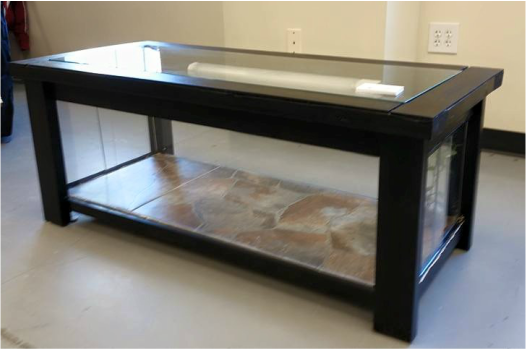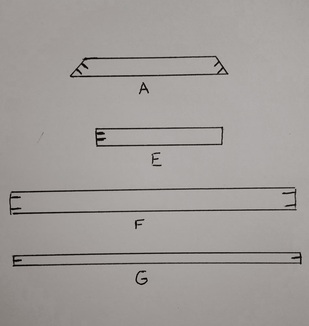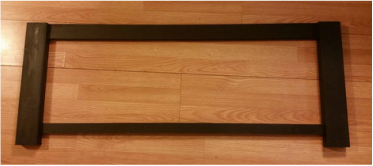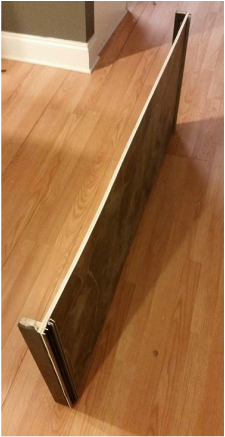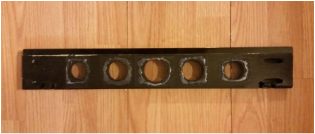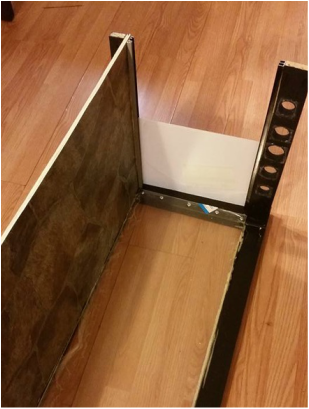Reptile Coffee TableThis is an elegant way to integrate your pet into your home. Who says you have to enjoy your pets less just because they are in a cage?
This unit, as designed, contains 1 enclosure 49" long x 19.5" wide x 17.5" tall. It is built in four main parts, the top, the two long sides, and the floor. When completed the coffee table measures 52" long x 24" wide x 21" tall. |
Materials and ToolsLumber - Use any kind of wood you like, popular choices are cedar, pine or oak:
1- 8' x 4' 1/4" plywood sheets 2 - 6' pieces of 1" x 2" 2- 6' pieces of 1" x 3" 2-8' pieces of 2" x 4" 2-8' pieces of 2" x 6" 1/4" thick Glass and 1/4" Plexiglass: 2-plexi glass pieces cut to size of long side (about 44" x 15") 4-plexi glass pieces cut to size of short side doors (about 10.5" x 13.5") 2-plexi glass pieces of 19.5" x 3" (optional) 1- 1/4" glass table top 44" x 16" Glass Door Track: 2- 3' long sets of 1/4" E track (typically only available online) 1 -3' long set of 1/4" U track (optional) Pocket Screw Jig: 1 - pack of 100 coarse 1 1/4" screws for pocket screw holes Screen Wire: 1 - small piece (~1' x 1') Glue Gun: 1 - pack of about regular glue sticks Linoleum: 2 - linear feet sheet vinyl flooring Glue: 1 - large bottle of gorilla glue or similar 1 - bottle of wood glue Wood Stain: 1 - can of wood furniture stain Misc: 1 - pack of hooks for hanging light sockets and decor 1 - pack of small zip ties 1 -1.5" hole saw 1 - pack of 1/2" screws with a flat head 1 - pack of 1/2" screws with a flat underside of the head 1 - can of plastic spray paint (optional) Reptile Items (as needed): 2 - under tank heat pads 2 - heat lamp sockets 1 - 24" UVB light fixture 2 - twist in light sockets 2- sliding glass door locks |
Step 1: Lumber CutsThe top of the coffee table will be made using the following cuts:
2 - 24" pieces of 2" x 6" cut at a 45 degree angle (part A) 2 - 52" pieces of 2" x 6" cut at a 45 degree angle (part B) 2- 52" x 4" 1/4" plywood (part C) 2- 16" x 4" 1/4" plywood (part D) The two long sides of the coffee table are made from the following cuts: 4 - 19.5" pieces of 2" x 4" (table legs - part E) 2 - 43.5" pieces of 1" x 3" (horizontal beam - part F) 2- 43.5" pieces of 1" x 2" (horizontal beam - part G) The floor of the coffee table is made from the following cuts: 1 - 49" x 19.5" piece of 1/4" plywood (table floor- part H) 2- 19.5" pieces of 1"x2" (horizontal side beam - part I) Miscellaneous support beams of the coffee table is made from the following cuts: 3- 19.5" piece of 1" x 3" (beam to support floor or hold sides together - part J) Step 2: Pocket Screw HolesUsing a pocket screw jig, drill the holes in the following pieces:
Part A - Drill a total of 4 holes in each piece Sides: 2 holes 1.5" from each edge on each side, flush with the 45 degree angle Part E - Drill a total of 2 holes in the piece Top: 2 holes 1" from the edge Parts F and J- Drill a total of 4 holes in the piece Sides: 2 holes 0.25" from each edge on each side Parts G and I - Drill a total of 2 holes in each piece Sides: 1 hole in the center on each side Print Shop in the UPS Store Sayre PA |
Step 3:
|
On a flat and level surface, arrange parts A and B to make a table top. One at a time clamp the joints together and use pocket screws and wood glue to hold them together. Let the glue dry.
Place the glass piece on the opening of the table top and center it exactly. Mark where the glass ends. Line up parts D to the marks to make a glass inlay. Use a combination of wood and gorilla glue to glue town parts D one at a time with clamps. Continually check that the glass will fit the inlay area. Now repeat these steps with parts C. The short ends of part C may need to be sanded down to fit between parts D. Once the table top is completely dry sand the edges so that the outside of C and D are flush with the outside of A and B. Check again that the glass inlay will fit. If not, sand the inside edge of parts C or D. Drill pilot holes for hooks and screws to mount any lighting you need. Stain the table top with the color of your choice. Print Shop with the UPS Store in Sayre Pennsylvania |
